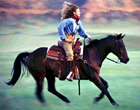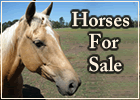

Laying Down and
Upset With Other Horses
Hi Ed
Hello, this is Jessica, The first problem is that during summer camp Banjo laid down with one of the kids on him, we got her off and he didn't try to roll or anything he just laid down and once the child was off he rolled to the side and then got back up. He barely worked so I know he wasn't tired. What should we do if he lays down again?The second issue is that we are doing two drills for the special olympics where two of the horses have to walk together and pass each other, but a couple of the horses absolutely do not like being next to each other. Mostly they lay back their ears but some of them get pretty upset to the point that they may stat kicking or biting. So what would you suggest for teaching them to get along next to each other?
Thank you very much,
Jessica
Hi Jessica,
Good to hear from you! As far as Banjo laying down, I think he is doing it from being bored and because the sand feels good to him but he can be taught that he is not allowed to lay down. When you set him up for this as a training session you will want to carry a dressage whip when you ride him. If, while mounted, you feel like he is about to lay down you should get him trotting fast forward immediately. Use the whip if necessary but he must move out immediately. This will change his mind about laying down.
If he lays down before you can get him moving out then use the whip on his rump sharply to jump him right back up on his feet. Don't let him roll or spend any time on the ground. Jump off and use the whip quickly to get him right up immediately. He needs to know he made a major mistake by laying down. Laying down must become very uncomfortable for him immediately. This may take a few training sessions to really teach him not to lay down. Then when leading him with a therapeutic rider carry the whip so he can see you have it. This will discourage him from thinking about laying down.
For the drill horses that get upset about being close to other horses, first teach them hindquarter disengagement from the ground and from the saddle just like we did in the clinic. After that set them up in a training session. Have one other rider approach alongside but not too close then again a little closer. The instant your horse shows any signs of being upset (ears back, reaching toward the other horse to bite, etc.) then you must immediately put her into a fast, hard, tight hindquarter disengagement for several circles then ride off like nothing happened. Set her up again and repeat as many times as necessary until she gets the idea that as soon as her ears go back her hind has to work around in tight, fast circles.
If you do this instantly and vigorously she will think it is something she is doing to herself by putting her ears back. You will be using hindquarter disengagement as a discipline. It is a constructive consequence not a punishment. It is good for her and helps to strengthen her hocks and stifles while making her more flexible in the lower spine but something she would probably rather not do. She is paying a price for making an ugly face or acting upset about the other horse. You have to make the price too expensive for her in terms of work so she decides she needs to accept the other horse being close to her in order not to have to do hindquarter disengagements. When she starts to understand the consequences then you can raise the standard by bringing a second horse to come along her other side so she is between two horses. For this to be successful you must be consistent. You absolutely must do a fast, tight hindquarter disengagement every single time she acts upset! If you skip one then she will lose confidence in you as a leader and she will think she can get away with being upset and ugly to the other horses sometimes. If you are consistent with this discipline she will learn to quietly accept other horses alongside her. I have been successful using this method in the past with several other horses that wanted to kick and bite any horse that got near them.
Enjoy the Journey,

Ed Dabney is an internationally acclaimed clinician, presenting horsemanship and riding clinics all over the US and in Europe. In 2007, Ed was named Champion of the East Coast Trainer Challenge Series by Equine Extravaganza. Ed was honored to have been selected by the University of Georgia to teach their senior level Young Horse Training course.
His training articles have appeared in many major national magazines. Ed produces instructional videos and the “Gentle Horsemanship” TV program which has been seen on RFD-TV.
Ed's blending of natural horsemanship and classical equitation has made an indelible mark with students all across the United States and now also in Europe, drawing the attention of serious riders searching for the lightest touch and the deepest connection with their horses irrespective of breed or discipline.


